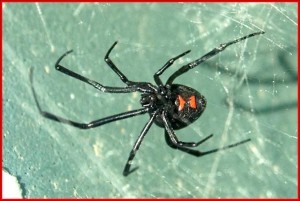Every so often the local news reports that a dangerous spider was found in supermarket-bought fruits, such as grapes and bananas from South America. Black widow spiders have appeared in the Northern part of the United States where, presumably, these spiders do not belong! And it’s newsworthy.
What many people do not know is that a native species of black widow, the Northern black widow spider, exists as far north as Ontario, Canada. They have been recorded in several Northeastern states. Compared to its cousin, the Southern black widow, the Northern widow is somewhat rare in its native range, but loves the same habitats, including barns, sheds, basements, wood piles, greenhouses and other dark, damp corners of the human environment. The Northern widow can be distinguished from the Southern species by the red hourglass spot on the underside of the abdomen. Northern species have a distinctly separated hourglass, while the Southern spider’s is joined. Northern widows also have white markings and red spots on the top of the abdomen. Both species have a body length of about ½ inch, long legs and a globe-shaped abdomen.

The venom of each widow species is similar and can cause reactions ranging from pain in the abdomen, sweating and nausea to serious systemic reactions like weakness, tremors, muscle spasms, and in extremely rare cases, death. Basically, you want to avoid being bitten. But widow spiders are reclusive and usually retreat when provoked. People are bitten when widow spiders are cornered (in a shoe or glove) or handled. Many times, people don’t even know that they have been bitten until the pain begins.
On a recent IPM visit to a plant nursery in Staten Island, we identified a healthy population of Northern black widow spiders living in the corners of greenhouses, underneath benches and in folds of cloth lining planting beds. Workers reported seeing these spiders for years, yet nobody has ever been bitten. Our IPM recommendations were to:
- Clean out spider webs, spiders and the egg sacs (perfectly round, tan balls hanging in webbing) with a broom or power-washer on a regular basis.
- Increase light and decrease moisture whenever possible and especially where people are working.
- Raise awareness among workers to look for spider habitat and recognize spiders and egg sacs. It was also advised that employees wear gloves when working with plants and soil.
- As a last resort, a pyrethrum or pyrethrin spray can be used to knock down spider numbers and the insects they dine on in greenhouses.
Ordinarily we don’t see a need for controlling or killing spiders because they are beneficial and generally harmless to people. In this case, no worker has ever been bitten by a black widow, despite their long-term presence in this nursery. Precautions, such as live spider and egg sac removal and spider awareness among workers, may be all that is needed to protect people from spiders and pesticides that may otherwise be used for black widow spider control.